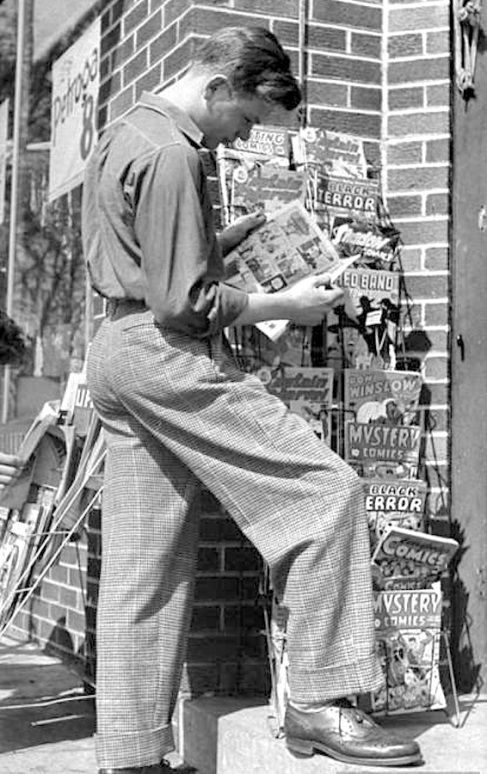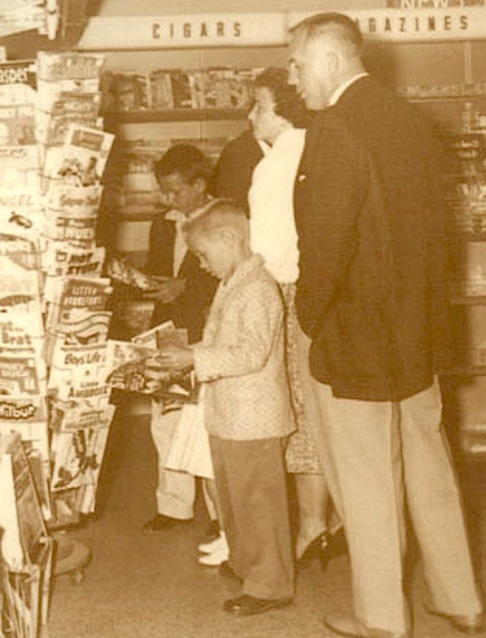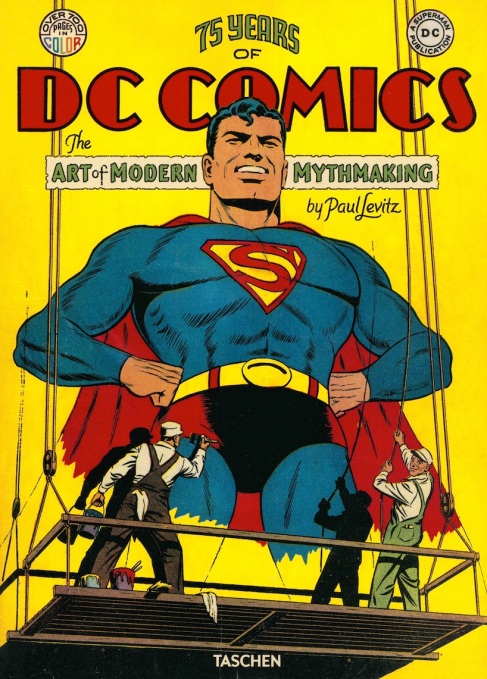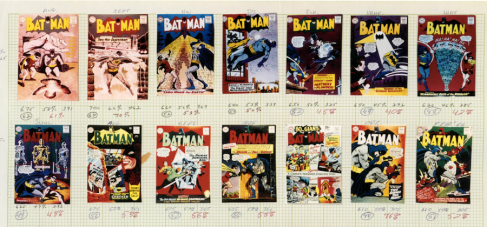
A precursor of The Office’s Jim Halpert looks at comics on sale. Oddly enough, not one DC comic on this rack. Based on the cover of Don Winslow of the Navy #26 and Red Band Comics #4 or 5 (both used the same art!), this was taken in March of 1945.
As a kid, I would read any comic book I could get my hands on, but my favorites were DC Comics. The writing, characters and production values were, to me, the best of anything out there. I liked other brands, like Harvey, Archies and Dell, but DC was tops.
Marvel Comics, at that time, was not making superhero comics; their offerings were mainly books about monsters or takeoffs on comics produced by other companies. If Harvey Comics put out Casper, the Friendly Ghost, Marvel would put out Homer, the Happy Ghost, and Charlton Comics, the bottom of the barrel in production values, put out Timmy, the Timid Ghost. One day, I’ll do a blog entry on the laughable print quality of Charlton Comics; they were usually printed so far out of register that they looked like the old red-blue 3-D comics.
So it was mainly DC for me!
My primary fascination was the drawing, but I was also intrigued by the production aspects of the things:
• How did they get from typewriter and pencil to the finished book?
• How did they print the 64 colors used?
• How come some comics used line screens for colors and some used dot screens?
• How did they get the logos and such so perfect on each issue?
• Who owned the company (DC at that time was called National Periodical Publications, Inc)?
• How did all the drugstores and newsstands get these books on the racks every other Tuesday morning?
• How much did the ads in the books cost and did they bring in dimes from the readers?
• How many copies of each comic did they print?
• How come some comics were monthlies and some were bi-monthlies?
• Why was the cost a dime?
What kind of company makes comic books?!?!??

When I was a kid, drugs stores were the best place to buy comics, as they seemed to carry all the issues published. Based on the cover of Action Comics #243 in this photo, it was taken in May of 1958. Yes; I am a geek! Had this photo been taken in Pascagoula, Mississippi, that could have been me in the pale jacket reading Strange Tales #65.
That was the stuff I wondered about.
I needed the following book: 75 Years Of DC Comics: The Art Of Modern Mythmaking, written by Paul Levitz, former president and publisher of DC Comics.

Nice touch: The title lettering mimics the lettering used on DC’s Action and Adventure comic book titles.
720 pages in a large, 15-1/2″ x 11-1/2″ format, weighing in at about 15 pounds, this is a stunner of a book. Absolutely engrossing, written in an amusing yet authoritative style, it’s simply the best history of comic books out there, and I’ve read ’em all. It’s expensive at over $150, but if that’s what it costs, so be it. It’s well worth more than that.
The book, heavily illustrated with comic covers and interior pages as you might expect, is augmented by rare photos of DC folks, from founders Malcolm Wheeler-Nicholson, Harry Donenfeld and Jack Liebowitz to production folks like Sol Harrison, Jack Adler, and, of course, many of the art and writing talents from DC’s history. Associated media, like cartoons, TV shows and films are well covered, too.
For me, whose interest in primarily in the marketing and print-production aspects of the comic books, a fascinating discovery was the cover/sales chart sheets kept by Irwin Donenfeld, Irwin was the son of DC co-founder Harry Donenfeld, and was co-owner, editorial director and vice-president of DC from about 1948 to 1968. These hand-drawn charts showed the covers of each DC comic by month, with notations of the size of the print run and percentage of copies sold written under each cover.

Notice the Batman logo change on this series of covers from the mid-1960s; one of Irwin Donenfeld’s sales charts.
Brilliant.
75 Years of DC Comics: Buy it, borrow it or check it out from a library; it is an amazing piece of work! You will learn something new on every page and the visual appeal is breathtaking. Here’s the Barnes & Noble info:









































